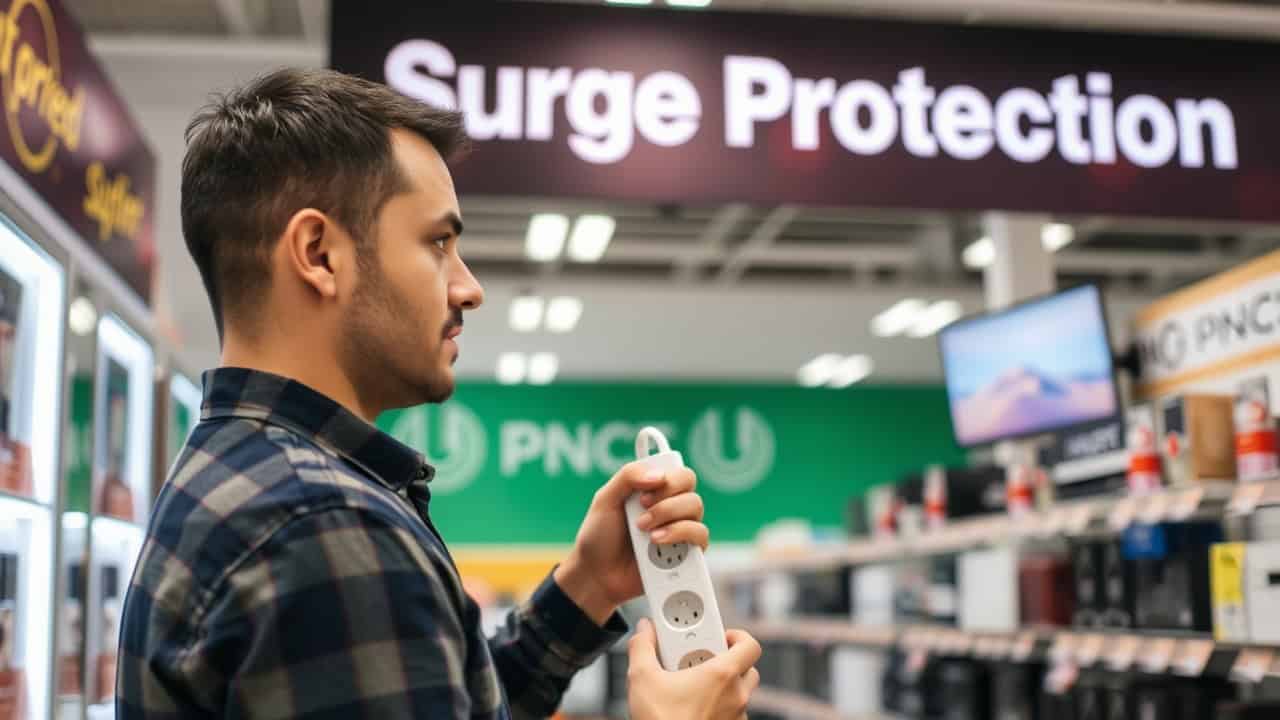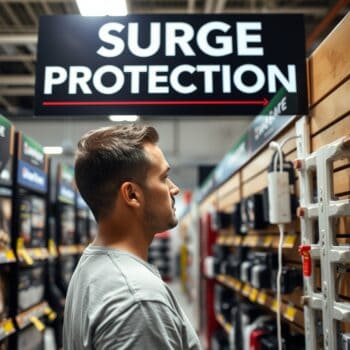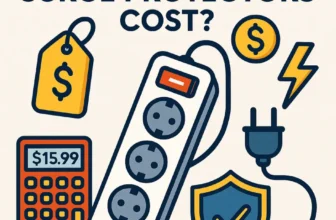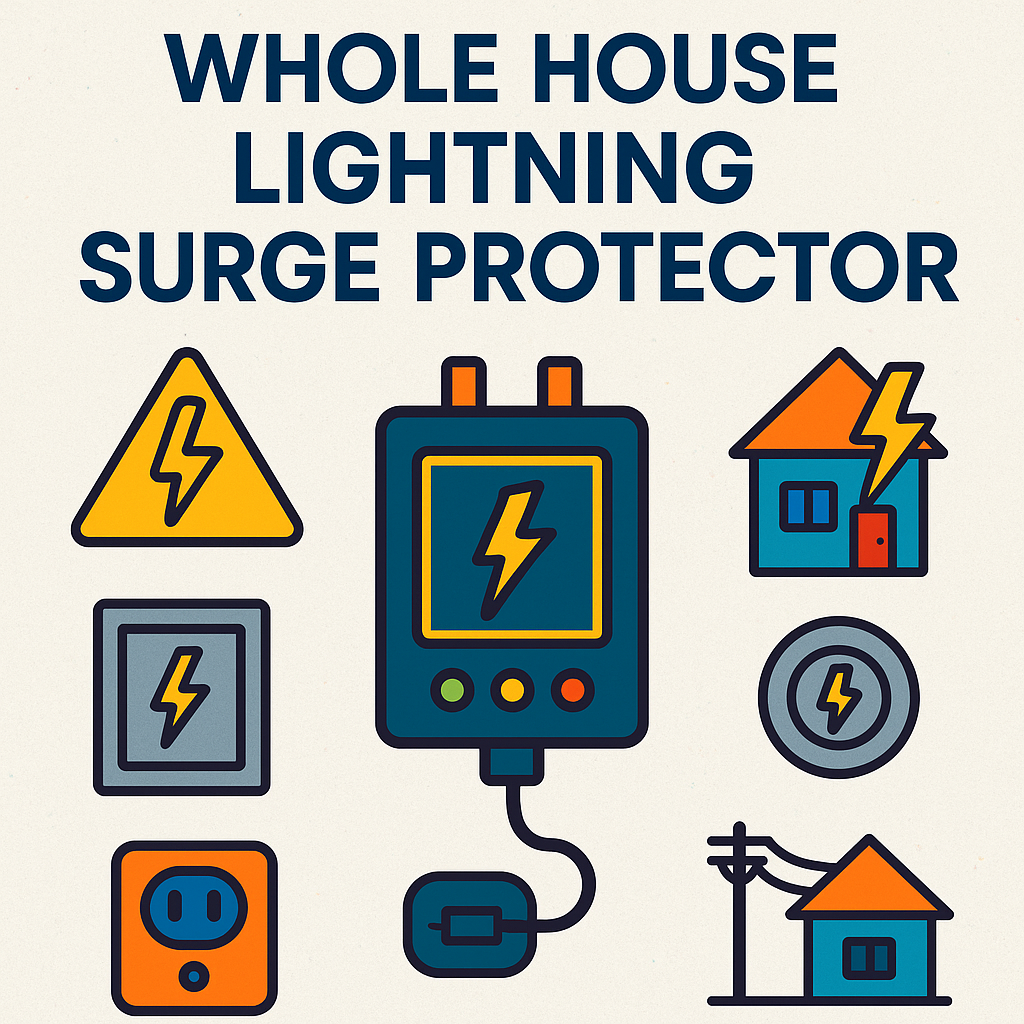Published By: Sean Hudson | Last updated on June 11, 2025 and reviewed by Editorial Team
 Have you ever had a power surge fry your expensive electronics? It’s a sickening feeling. You’re left wondering, “Why didn’t I invest in a surge protector?” The truth is, most of us don’t give surge protection a thought until it’s too late.
Have you ever had a power surge fry your expensive electronics? It’s a sickening feeling. You’re left wondering, “Why didn’t I invest in a surge protector?” The truth is, most of us don’t give surge protection a thought until it’s too late.
Yet, surge protection devices have seen growing demand over the recent years. The global surge protection devices market size was valued at $2.89 billion in 2022 and is expected to grow at a CAGR of 6.8% from 2023 to 2030. Here’s the thing: surge protectors are like insurance for your electronics. You hope you never need them, but when you do, you’re grateful you have them.
Just like you wouldn’t drive without car insurance, you shouldn’t plug in your valuable devices without a surge protector.
Getting surge protectors for your home electronics and appliances is a small investment that can save you a lot of heartache (and money) in the long run.
But, how do you choose the right surge protector?
With so many options on the market, it can be overwhelming. Do you need one with a high joule rating? What about clamping voltage? And what’s the deal with those little lights on some surge protectors?
Don’t worry; we’ll break it all down for you in this comprehensive guide.
Understanding Surge Protectors
What is a surge protector?
Ever plugged in your phone charger during a thunderstorm and wondered if it’s safe? That’s where surge protectors come in. These unsung heroes of the electrical world act as a shield between your valuable electronics and the unpredictable power grid.
At its core, a surge protector is a device that detects excess voltage and diverts it away from your equipment. Think of it as a bouncer at an exclusive club, only letting in the right amount of power and keeping the rowdy, potentially damaging surges out.
But here’s the kicker: not all surge protectors are created equal.
Some can handle massive power spikes, while others might falter under pressure. That’s why understanding what makes a good surge protector is important for keeping your gadgets safe.
How surge protectors work to safeguard electronics
Let’s get a bit technical, but I promise to keep it simple.
Surge protectors use components called Metal Oxide Varistors (MOVs). These little marvels act like electrical sponges, absorbing excess voltage when it exceeds a certain threshold.
When a surge hits, the MOV diverts the extra electricity to the ground wire, keeping your devices safe. It’s like a pressure relief valve for electricity.
Pretty cool, right?
But here’s something many people don’t realize: surge protectors have a finite lifespan. Each time they absorb a surge, they degrade a little. It’s like a boxer taking punches – eventually, they’ll need to retire.
Types of surge protectors
Now, let’s break down the different types of surge protectors you might encounter:
- Wall-mounted surge protectors: These plug directly into your wall outlet. They’re compact and great for protecting individual devices.
- Power strip surge protectors: The most common type. They offer multiple outlets and often include additional features like USB ports.
- Whole-house surge protectors: These bad boys protect your entire home. They’re installed at your main electrical panel and provide the first line of defense against external surges.
Each type has its pros and cons.
Let’s compare them in this handy table:
| Type | Protection Level | Number of Outlets | Portability | Cost |
|---|---|---|---|---|
| Wall-mounted | Medium | 1-2 | High | $ |
| Power strip | Medium-High | 6-12 | Medium | $$ |
| Whole-house | Very High | N/A | None | $$$ |
Did you know that some high-end surge protectors use gas discharge arrestors in addition to MOVs? These components can handle massive surges, making them ideal for areas prone to lightning strikes.
Remember, choosing the right surge protector is like picking the right tool for a job. You wouldn’t use a sledgehammer to hang a picture, right?
Similarly, you should match the capability of the surge protector to your specific needs and the devices you’re protecting.
Factors to Consider When Choosing a Surge Protector
Joule rating
When shopping for a surge protector, one of the first things you’ll notice is the joule rating. But what exactly does this mean, and why is it important?
Simply put, the joule rating tells you how much energy the surge protector can absorb before it fails. It’s like the amount of punishment a boxer can take before going down for the count.
The higher the joule rating, the more protection your devices will have against power surges.
As a general rule of thumb, look for a surge protector with a joule rating of at least 600 for small electronics, 1000 for home office equipment, and 2000+ for high-end electronics like gaming consoles and home theater systems.
To put this into perspective:
| Device Type | Recommended Joule Rating |
|---|---|
| Small electronics (phone chargers, lamps) | 600+ |
| Home office (computers, printers) | 1000+ |
| Entertainment systems (TVs, gaming consoles) | 2000+ |
Number of outlets and spacing
Have you ever tried to plug in a bulky power adapter, only to find that it blocks the adjacent outlet? It’s frustrating, right? That’s why the number of outlets and their spacing is another key factor to consider when choosing a surge protector.
Ensure the surge protector you choose has enough outlets to accommodate all your devices, with sufficient room for future additions. A good rule of thumb is to count the number of devices you need to plug in and add two extra outlets for flexibility. Pay attention to the spacing between outlets, too. Some surge protectors feature wider spacing or pivoting outlets to accommodate bulky plugs without blocking other outlets.
Trust me; this small detail can make a big difference in the long run.
UL certification
Would you trust a babysitter who didn’t have any references or certifications? Probably not. The same goes for surge protectors. When entrusting your valuable electronics to a surge protector, you want to make sure it’s been tested and certified by a reputable organization.
Enter UL (Underwriters Laboratories), a global safety certification company that tests and verifies the safety of electrical products. When a surge protector bears the UL seal, you can be confident that it has undergone rigorous testing and meets strict safety standards.
To find a UL-certified surge protector, look for the UL logo on the packaging or product itself. You can also check the UL Online Certifications Directory to verify a product’s certification.
Clamping voltage
Imagine you’re at a carnival, playing the game where you have to hit the lever at just the right time to make the puck go into the highest slot. The lower you let the puck drop before hitting the lever, the less likely you are to win the big prize.
Clamping voltage is like that lever – the lower the clamping voltage, the better the protection for your devices. Clamping voltage refers to the voltage at which the surge protector starts to divert excess electricity away from your devices. A lower clamping voltage means the surge protector will kick in sooner, providing better protection against smaller surges that can still damage your electronics over time.
Ideally, look for a surge protector with a clamping voltage of 400 volts or less. Some high-end surge protectors even offer clamping voltages as low as 330 volts for ultra-sensitive electronics.
Response time
In the world of surge protection, speed is everything. The faster a surge protector can respond to a power surge, the better it can protect your connected devices. This is where response time comes into play.
Response time, measured in nanoseconds (ns), refers to how quickly the surge protector can detect and divert a power surge. The shorter the response time, the more effective the surge protector will be at safeguarding your electronics. When shopping for a surge protector, look for one with a response time of 1 nanosecond or less.
Some high-end models boast response times as quick as 0.5 nanoseconds, providing an extra layer of protection for your most valuable devices.
To put response time into perspective, consider this: a single nanosecond is to one second as one second is to 31.7 years. In other words, a nanosecond is an incredibly short amount of time, and when it comes to protecting your electronics from power surges, every nanosecond counts.
Additional features
While joule rating, outlet spacing, UL certification, clamping voltage, and response time are the most important factors to consider when choosing a surge protector, some additional features can make your life easier and provide extra protection for your devices.
One such feature is USB charging ports. Many modern surge protectors come equipped with built-in USB ports, allowing you to charge your smartphones, tablets, and other USB-powered devices without taking up an extra outlet.
This is especially handy for home offices or entertainment centers where multiple devices need charging.
Another feature to look for is protection for telephone, coaxial, or Ethernet lines. While most people associate power surges with electrical outlets, surges can also travel through these other types of lines and damage connected devices. Some surge protectors offer additional jacks for these lines, ensuring comprehensive protection for all your electronics.
Finally, consider the warranty and insurance coverage offered by the surge protector manufacturer. Many reputable brands offer warranties ranging from one to five years, giving you peace of mind knowing that your investment is protected.
Some even offer connected equipment insurance, which will reimburse you for any devices damaged by a power surge while connected to the surge protector (up to a certain amount).
Choosing the Right Surge Protector for Specific Needs
Home office electronics
If you’re like most people, your home office is your command center – it’s where you get work done, pay bills, and stay connected with the world.
But all those electronics that make your home office hum are also vulnerable to power surges. That’s why choosing the right surge protector is essential for keeping your workspace up and running. When shopping for a surge protector for your home office, look for one with a high joule rating (at least 1000), multiple outlets, and wide spacing to accommodate bulky plugs.
Some surge protectors even come with built-in USB ports, perfect for charging your smartphone or tablet while you work.
Another feature to consider is protection for telephone and Ethernet lines. Many home office setups include a modem, router, or printer connected via these lines, and a surge protector with the right jacks can help safeguard these devices from surges coming through the lines.
| Home Office Device | Recommended Surge Protector Features |
|---|---|
| Computer | High joule rating, multiple outlets |
| Printer | Telephone/Ethernet protection |
| Modem/Router | Coaxial protection, Ethernet protection |
Entertainment systems
Movie night just got an upgrade! Your entertainment system is the heart of your home theater experience, but it’s also a significant investment that needs protection from power surges. After all, you don’t want a sudden surge to fry your new 4K TV or gaming console.
When choosing a surge protector for your entertainment system, prioritize a high joule rating (2000+) and multiple outlets to accommodate all your devices.
Look for a surge protector with coaxial and Ethernet protection to safeguard your cable box, streaming devices, and gaming consoles from surges coming through those lines.
Some high-end surge protectors even offer features like noise filtering and automatic voltage regulation, which can help improve picture and sound quality by reducing electromagnetic and radio frequency interference. It’s like giving your entertainment system a spa day!
| Entertainment Device | Recommended Surge Protector Features |
|---|---|
| HDTV | High joule rating, coaxial protection |
| Gaming console | Ethernet protection, multiple outlets |
| Soundbar/Speakers | Noise filtering, automatic voltage regulation |
Kitchen and household appliances
Your kitchen may not be the first place you think of when it comes to surge protection, but it should be. Large appliances like refrigerators, dishwashers, and microwaves can be particularly vulnerable to power surges, and a damaged appliance can be costly to repair or replace.
For kitchen and household appliances, consider investing in a whole-house surge protector.
These devices are installed at your home’s main electrical panel and protect every device connected to your electrical system. With that, you don’t have to worry about individual surge protectors for each appliance – one device does it all.
If a whole-house surge protector isn’t in the cards, look for individual surge protectors with high joule ratings (2000+) and a clamping voltage of 400 volts or less.
Ensure the surge protector is rated for the wattage of your appliance; you can find this information in the appliance manual or on the manufacturer’s website.
- 4 Led Indicators: Light indicators for Normal Voltage, Over Voltage, Low Voltage and Waiting Cycle. 4 Mode Led Indicator can let you know the power status of your home appliances in a simple and clear way. Directly Plug In Design—Easy to use.
- Professional Protection: Protect against high and low voltage, brownout, spike, instant surge, power failure, voltage fluctuation and load shedding
- Best Surge Protector for Home Appliance: Suitable for Refrigerator, Air Conditioners, PC, TV, Freezers, Ice Makers, Washing Machines or other valuable household electronic.
- 3 Mins Period Time: Sometimes multiple voltage surge may occur within one minute. A short-term delay surge protector can cause the refrigerator power cycling quickly, potentially causing significant damage to the compressor. To protect your valuable home appliances, we recommend using BSEED surge protector with a 3-minute delay.
- Lifetime Support & Warranty: Backed by BSEED’s 3-year warranty and 24/7 customer service, your investment is fully protected. Our surge protector comes with a no-questions-return policy. Join 50,000+ satisfied customers who trust BSEED surge protection products for valuable electrical system—now for peace of mind in your warm home.
- ULTIMATE SURGE PROTECTION: Protect your electrical equipment and home appliances from voltage spikes, momentary surges, voltage fluctuations, and outages caused by hurricanes or tropical storms. This state-of-the-art power surge protector ensures maximum protection for your devices
- RELIABLE AC PROTECTION: Tested for over 10 years by our engineers and with over one million pieces sold in the market, our Power Surge Protector was designed with reliable AC protection to safeguard your devices from power surges and voltage fluctuations. Keep your appliances running smoothly and be worry-free
- TAILORED FOR REFRIGERATOR SAFETY: Unlike general surge protectors, the LUDX-RF is specially engineered to meet the unique power protection needs of refrigerators. It helps prevent compressor damage caused by sudden power returns—providing reliable, long-term protection and giving you peace of mind
- 4-MINUTE SAFETY CYCLE: This protector incorporates a 4-minute safety cycle to ensure maximum protection during voltage fluctuations. The device encounters voltage fluctuations and will protect the device by providing output until the voltage is stable. The device will delay for 4 minutes and work again
- MAX CAPACITY: 1875 Watts | WORKING VOLTAGE: AC 120V/60Hz | SAFETY RANGE: AC 85-135V±3%
- POWER FAILURE ALARM + SURGE PROTECTION: This power failure alarm device, compared to similar products on the market, adds surge protection functionality. You no longer need to agonize over choosing between power failure alerts and surge protection. With just one device, you can enjoy dual protection, not only comprehensively safeguarding your refrigerator or other appliances but also saving you costs
- DESIGNED FOR ELECTRICAL PROTECTION: This newly upgraded power fault alarm is designed to monitor and protect household appliances such as refrigerators operating on 120VAC, preventing accidental disconnection of power lines or circuit breaker failure, high and low voltage, spike, instant surge, power failure, voltage fluctuation, and load shedding leading to appliance damage. It extends the lifespan of appliances, reduces appliance losses, and saves on maintenance costs for you
- POWER OUTAGE ALERT: In the event of a power failure, the alarm will notify you of the power issue through flashing alarm lights and a 110dB loud alarm, enabling you to salvage your property and equipment, thus preventing situations such as food spoilage due to refrigerator power outages
- CLEAR PANEL: With LED lights displaying voltage status clearly labeled, providing intuitive clarity, enhancing your understanding efficiently, ensuring appliances operate according to your needs
- TIME AND EFFORT SAVING: Equipped with a built-in rechargeable high-quality lithium battery boasting extended battery life, this device eliminates the inconvenience of frequent replacements. With its plug-and-charge feature, it automatically charges when plugged in, effectively preventing the risk of missed alerts due to forgetting to charge or replace batteries
Remember, investing in the right surge protector for your kitchen and household appliances can save you a lot of money and headaches down the line.
Plus, it gives you peace of mind knowing that your appliances are protected from the unexpected.
Installation and Maintenance
Proper installation techniques
You’ve done your homework and chosen the perfect surge protector for your needs.
Great job!
But hold on – the way you install your surge protector is just as important as the device itself. Think of it like baking a cake: you can have the best ingredients, but if you don’t mix them properly, you won’t get the desired result.
First things first, always plug your surge protector directly into a wall outlet. I know it’s tempting to daisy-chain surge protectors or use extension cords, but this can actually reduce the effectiveness of your protection and create a fire hazard.
It’s like trying to fit too many people into a lifeboat – it just doesn’t work.
Next, make sure you’re not overloading your surge protector. Each device has a maximum amperage rating, and exceeding this can lead to overheating and potential fire risks.
Here’s a handy table to help you keep track:
| Device Type | Typical Amperage Draw |
|---|---|
| Laptop | 0.5-3 amps |
| Desktop Computer | 2-5 amps |
| TV (LED/LCD) | 1-2 amps |
| Gaming Console | 1-3 amps |
| Refrigerator | 3-6 amps |
Remember, the total amperage of all connected devices should not exceed the surge protector’s rating. It’s like managing a budget – you don’t want to overspend!
Lastly, pay attention to the indicator lights on your surge protector. Most models have a light that shows when the protection is active.
If this light goes out, it means your surge protector has done its job and absorbed a surge, but it may no longer offer protection. Time to replace it!
Regular maintenance and replacement
Now that you’ve got your surge protector installed correctly, you might think your job is done. But here’s the thing: surge protectors don’t last forever. They’re like the bodyguards of the electronics world, taking hits so your devices don’t have to.
But even the toughest bodyguard can’t keep fighting forever.
So, how often should you replace your surge protector? As a general rule, plan to replace them every 2-3 years.
However, if you live in an area with frequent thunderstorms or power issues, you might need to replace them more often. It’s like changing the oil in your car – regular maintenance keeps everything running smoothly.
But how do you know when it’s time to say goodbye to your trusty surge protector? Look out for these signs:
- The protection indicator light is no longer lit
- There are signs of damage or discoloration on the surge protector
- It feels hot to the touch during normal use
- You’ve had it for more than 3-5 years
Here’s a quick reference table for surge protector lifespan:
| Usage Scenario | Recommended Replacement Frequency |
|---|---|
| Normal household use | Every 2-3 years |
| Areas with frequent storms | Every 1-2 years |
| High-value electronics | Every 1-2 years |
In addition to replacement, don’t forget about regular maintenance. Every few months, unplug your surge protector and give it a once-over. Check for any signs of wear and tear, loose connections, or damage.
It’s like giving your car a quick inspection before a long road trip – a little prevention goes a long way.
And here’s a pro tip: keep a log of when you installed each surge protector and when you last checked it. You can use a simple spreadsheet or even jot it down in a notebook.
Trust me, your future self will thank you for this organized approach!
Remember, maintaining your surge protectors isn’t just about protecting your devices – it’s about protecting your home and family. A worn-out surge protector can be a fire hazard, so staying on top of maintenance and replacement is important. It’s a small effort that can make a big difference in the long run.
Surge Protector Safety Tips
When it comes to protecting your electronic devices from power surges, using a surge protector is essential. However, it’s equally important to follow proper safety guidelines to ensure the effectiveness and longevity of your surge protector.
Here are some surge protector safety tips to keep in mind:
- Avoid daisy-chaining surge protectors: Plugging one surge protector into another or using power strips with surge protectors can overload the electrical circuit, increasing the risk of overheating or electrical fires. Instead, use multiple surge protectors directly connected to separate outlets.
- Place the surge protector in a dry location: Moisture can damage the surge protector and increase the risk of electrical hazards. Install surge protectors in dry areas indoors, away from water sources and high-humidity regions.
- Don’t exceed the electrical rating: Each surge protector has an electrical rating specified by the manufacturer. It’s crucial not to exceed this rating by plugging devices that require higher amperage or wattage, as it can lead to overheating and potential damage.
- Regularly inspect the surge protector: Periodically check the surge protector for any signs of wear, damage, or frayed cords. If you notice any issues, replace the surge protector immediately to maintain optimal protection.
- Unplug during lightning storms or power outages: To safeguard your devices from electrical surges caused by lightning or power outages, it’s recommended to unplug your surge protectors during such events.
By following these surge protector safety tips, you can minimize the risk of electrical hazards, ensure the longevity of your surge protector, and protect your valuable electronic devices from power surges.
Final Thoughts
Choosing the right surge protector isn’t just about protecting your electronics – it’s about safeguarding your peace of mind.
Let’s recap the key points:
1. Surge protectors are essential for safeguarding your valuable electronics from power surges.
2. When choosing a surge protector, consider factors like joule rating, clamping voltage, response time, and UL certification.
3. Different devices and areas of your home may require different types of surge protection.
4. Proper installation and regular maintenance are crucial for ensuring your surge protectors continue to do their job effectively.
Remember, investing in a quality surge protector is a small price to pay compared to the cost of replacing damaged electronics. Whether you’re setting up a home office, creating the ultimate entertainment system, or just want to protect your kitchen appliances, there’s a surge protector out there that’s perfect for your needs.
Don’t wait until it’s too late – take action now to protect your devices. Choose the right surge protector, and rest easy knowing your valuable electronics are safe from the unexpected zaps and jolts of everyday life.











